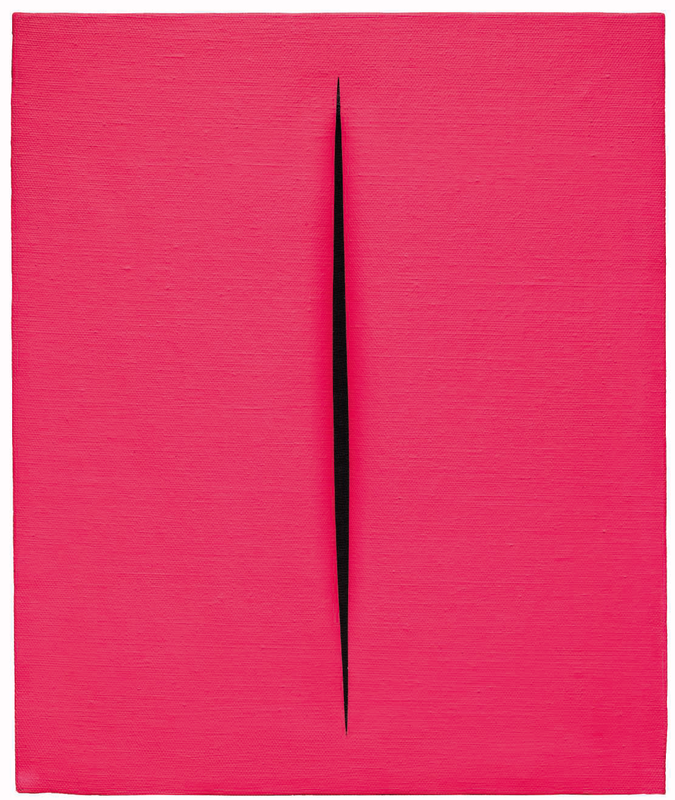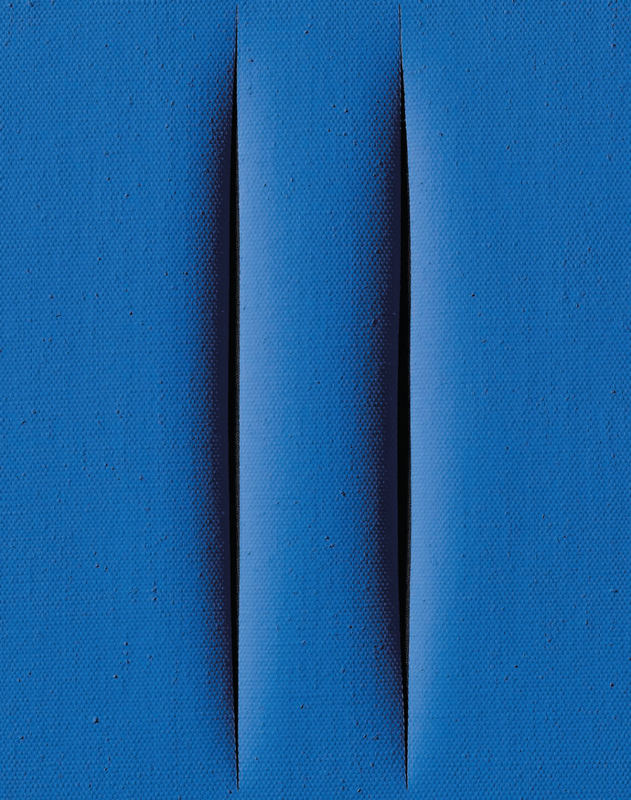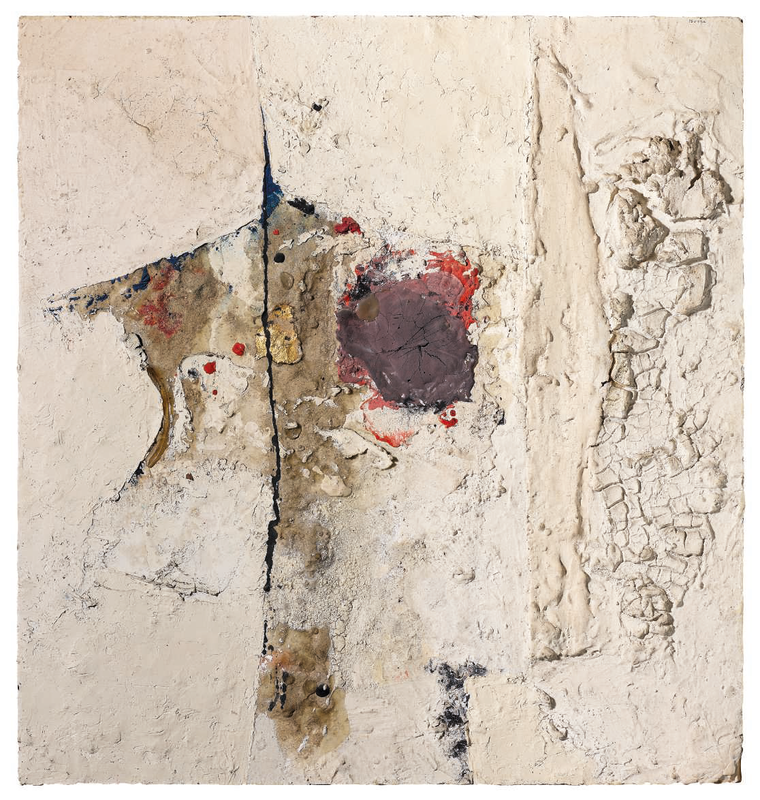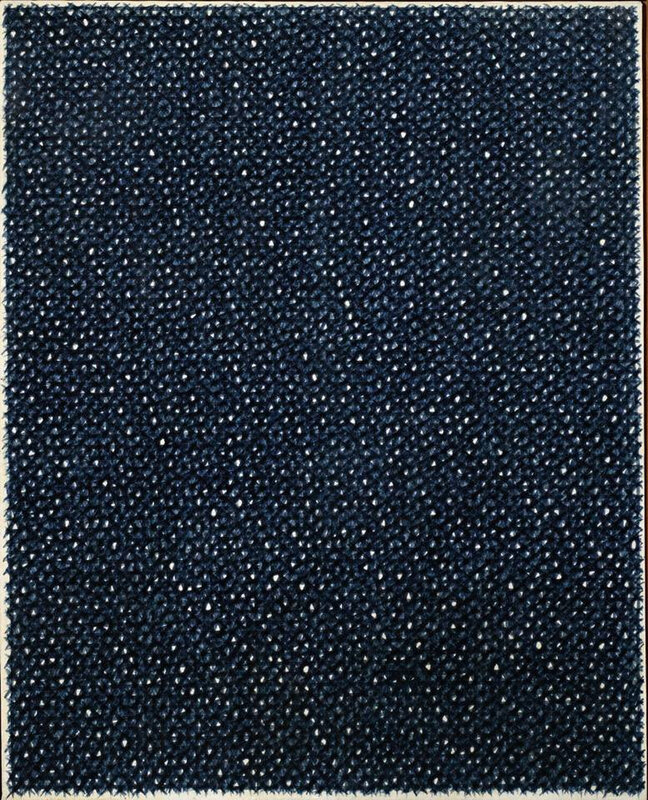Christie's sale in Milan to offer the best of 20th century Italian art
MILAN.- Dedicated to offering the best of 20th century Italian art, Christie’s annual auction in Milan, now part of the Thinking Italian series aligned with the global Post-War and Contemporary sales, will take place on 3 and 4 of April. Highlighted by Lucio Fontana’s intense pink-red Concetto Spaziale, Attesa (estimate: €800,000 – 1,200,000), the sale features historical works by major icons such as Gino Severini, Alberto Boccioni, Alberto Burri, Enrico Castellani and Piero Manzoni, through to a group of contemporary works led by Gino De Dominicis. The auction also includes a refined group of two still lifes and one landscape by Giorgio Morandi; a special selection from the series of "lattices" by Piero Dorazio; a collection of iconic 1960s works by Mario Schifano and an important group of paintings which trace the evolution of figurative art in Italy between the 1920s and the 1940s. A selection of highlights from Thinking Italian Milan will tour to the MAXXI Museum in Rome on 15 March, followed by Turin on 20 March, before the full sale exhibition in Milan from 29 March to 2 April 2019.
Lot 35. Lucio Fontana, Concetto spaziale, Attesa. Waterpaint on canvas, 55x46 cm. Executed in 1967. Estimate EUR 800,000 - EUR 1,200,000 (USD 901,620 - USD 1,352,430). Price realised EUR 850,000. © Christie's Images Ltd 2019
Provenance: Collezione Camuffo, Venezia
Galerie Couturier, Parigi
Collezione privata, Parigi
Centro Arte Internazionale, Milano
ivi acquisito dall’attuale proprietario a metà degli anni Settanta
Literature: E. Crispolti, Lucio Fontana. Catalogue raisonné des peintures, sculptures et environnements spatiaux rédigé par Enrico Crispolti, Bruxelles 1974, vol. II, p. 192, n. 67 T 74 (illustrato)
E. Crispolti, Fontana. Catalogo generale, Milano 1986, vol. II, p. 668, n. 67 T 74 (illustrato)
E. Crispolti, Lucio Fontana. Catalogo ragionato di sculture, dipinti, ambientazioni, Milano 2006, vol. II, p. 862, n. 67 T 74 (illustrato)
© Christie's Images Ltd 2019
“The discovery of the Cosmos is that of a new dimension, it is the Infinite: thus I pierce the canvas, which is the basis of all arts, and I have created an infinite dimension”. -LUCIO FONTANA
Note: With a single cut parting the centre of its rich, fuchsia-red canvas, Concetto spaziale, Attese (1967) is a serene and seductive example of Lucio Fontana’s most iconic series – the tagli (‘cuts’). The tagli were a philosophical gesture, and creative rather than destructive: in cutting the canvas open, Fontana transcended centuries of picture-plane-bound art history to reveal the black infinity of space beyond, in which he saw the limitless future of mankind in the ‘spatial era.’ Having first pierced the canvas with buchi (‘holes’) in 1954, Fontana spent some years experimenting with surface ornamentation including glass fragments, impastoed paint and glitter before arriving at the serenity of the monochrome tagli, which constitute the refined apex of his adventurous, constantly evolving formal vocabulary. By 1967, he was a consummate master of the cut, bringing the motion to surfaces of supreme, monochrome flatness with near-surgical perfection. The vivid hue of the present work, with its isolated cut like a single meteor streaking through space, forms a work of concentrated and almost erotic drama. ‘When I sit down to contemplate one of my cuts, I sense all at once an enlargement of the spirit,’ Fontana said. ‘I feel like a man freed from the shackles of matter, a man at one with the immensity of the present and of the future’ (L. Fontana, quoted in L. M. Barbero, ‘Lucio Fontana: Venice/New York’ in Lucio Fontana: Venice/New York, exh. cat. Guggenheim Museum, New York 2006, p. 23). Surpassing the physicality of its materials, Concetto spaziale, Attese creates a transcendental experience, both existing in the tangible world and extending, like a portal, into the timeless immateriality of a further realm. In front of the work, drawn into a chasm of unknown space, we stand with Fontana at the threshold of infinity.
The sale also includes a group of 9 works by post-war artists including Carla Accardi, Giulio Paolini and Piero Dorazio, the proceeds of which will benefit the Water Academy SRD, an international Research Center that seeks to raise awareness of issues relating to water, in line with the values of sustainable and responsible development, in order to promote a New Culture of Water.
Mariolina Bassetti, International Chairman, Post-War and Contemporary Art, Continental Europe, comments: ‘This year, our rebranded flagship sale ‘Thinking Italian Milan’ continues our tailor-made approach to satisfy the needs of our national and growing international collector group. After the launch of Thinking Italian in London two years ago, and the ongoing success for Italian art, we look forward to presenting international collectors in Milan with a tightly curated selection of pioneering Italian artists of the 20th century.’
Renato Pennisi, Director and Senior Specialist, Head of Sale, Christie's Italy comments – ‘This season, we are pleased to present collectors with a broad scope of works that trace the history of Italy’s prolific and varying artistic culture throughout the 20th century. Christie’s continues to be the only leading auction house to offer sales dedicated to 20th century Italian art and Milan confirms its status as a key location to buy the very best of this category.’
THE POETIC COMPOSITIONS OF GIORGIO MORANDI
A group of three elegant and lyrical works by Giorgio Morandi are presented in the sale. Painted in 1952, Morandi’s Natura morta embodies the contemplative, timeless nature that characterises the iconic still life paintings produced by the artist in the aftermath of the Second World War (estimate: €700,000– 1,000,000). Another Natura Morta, executed in 1947, (estimate: €500,000 - 700,000) depicts an equally poetic composition of household objects in delicate, muted tones of ivory, grey and ochre. Forming a significant portion of his practice, Morandi’s landscapes present a masterful technique in portraying rural tranquillity and abstract scenery. Influenced by Cezanne, Morandi’s landscape entitled Paesaggio, produced in 1943, is luminous and rich, capturing the almost shadowless light of noon, and demonstrates the great influence masters of the past had on his oeuvre (estimate: €280,000 – 350,000).
Lot 9. Giorgio Morandi (1890-1964), Still life, signed Morandi (bottom left), oil on canvas, 40x52cm. Executed in 1952. Estimate EUR 700,000 - EUR 1,000,000 (USD 788,917 - USD 1,127,025). Price realised EUR 1,570,000. © Christie's Images Ltd 2019.
Lot 25. Giorgio Morandi (1890-1964), Still life, signed Morandi (bottom right), oil on canvas, 34x46 cm. Executed in 1947. Estimate EUR 500,000 - EUR 700,000 (USD 563.512 - USD 788.917). Price realised EUR 1,030,000. © Christie's Images Ltd 2019.
Lot 36. Giorgio Morandi (1890-1964), Landscape, signed and dated Morandi 1943 (on the back), oil on canvas, 35.2x53.2 cm. Executed in 1943. Estimate EUR 280,000 - EUR 350,000 (USD 315,567 - USD 394,459). Price realised EUR 322,000. © Christie's Images Ltd 2019.
20th CENTURY ICONS OF ITALIAN ART
The sale includes several examples of Lucio Fontana’s iconic Concetto Spaziale series, most notably a seductive pink-red single cut canvas, as well as a blue Concetto Spaziale, Attese, from 1967 (estimate: €350,000 – 500,000). Superficie alluminio is a quintessential example of one of Enrico Castellani’s signature Superfici or ‘Surfaces’, the career-defining series which he begun in 1959 and continued to explore for the rest of his life (estimate: €300,000—500,000). Bianco, made in 1954 by Alberto Burri, (estimate: €300,000 -500,000) is part of the artist’s radical series, the Bianchi, which he began in 1949. The present lot was given by Burri to the father of the present owner on the occasion of his wedding in 1954.
Lot 8. Lucio Fontana (1899-1968), [Concetto spaziale], signed l. fountain (bottom right); signed l. fountain (on the back), oil on canvas, 46x38 cm. Executed in 1960. Estimate EUR 350,000 - EUR 500,000 (USD 394,459 - USD 563,512). Price realised EUR 586,000. © Christie's Images Ltd 2019.
Work registered at the Lucio Fontana Foundation, Milan, n. 381/2, as per authentication on photograph dated April 28th 1970.
Provenance: Galleria Cafiso, Milan
M. Rossello Collection, Milan
Bluart Gallery, Padua
acquired by the family of the current owner in the 1980s.
Literature: E. Crispolti, Lucio Fontana. Catalog raisonné des peintures, sculptures et environnements spatiaux rédigé par Enrico Crispolti , Bruxelles 1974, vol. II, p. 76-77, n. 60 O 65 (shown upside down)
E. Crispolti, Fontana. General catalog , Milan 1986, vol. I, p. 262, n. 60 O 65 (illustrated)
E. Crispolti, Lucio Fontana. Reasoned catalog of sculptures, paintings, settings , Milan 2006, vol. I, p. 426, n. 60 O 65 (illustrated).
Note: Lucio Fontana's 1960 spatial concept is composed of a single, vertical cut, which affects the white and sensual surface, made with a dense pigment. On this canvas covered with a thick oil paint, so that the passage of the spatula has left soft ripples and waves, an oval line is engraved that frames the central slot. Through a clear and minimal purity, this work celebrates not only Fontana's most significant gesture - the cut - but also enhances the artist's supreme mastery of this medium as well as his constant interest in the material aspect. Continuously oscillating between an exuberant embrace of the material and its refusal, the artist has never stopped exploring the possibilities of his materials. With the Oils- the series to which this spatial concept belongs - he reaches the height of extravagance. Through the application of dense masses of oil painting, and the creation of cuts and holes that penetrate the surface in a gesture of visceral abandon, Oils present themselves as the antithesis of contemporary cuts , and materiality and gestures embrace the dialectical poles of the art of Fontana.
The rich though minimal materiality of this work represents the embodiment of Fontana's changing vision of the universe and space travel. Fascinated by the revelation of space, he was completely enraptured by the fantastic visions and the possibilities that the discovery of this new scenario contained. With his cuts and his holes he expressed something of this feeling: the empty black space that formed on the other side of the canvas served as a metaphorical revelation of the infinite that governed the outer space. In 1960, the year in which he began to create Oilsand he realized this work, his concept of space had begun to change. Space travel was no longer a fantasy but had become an actual possibility - Yuri Gagarin was the first man to go into space the following year - and the artist's conception inevitably changed. He realized that "space is no longer an abstraction, but ... a real dimension in which man can really live, so that he can reach it with jets, Sputniks and spaceships" (Fontana, quoted in P. Gottschaller, Lucio Fontana: The Artist's Materials, Los Angeles 2012, p. 96). Consequently, the philosophical and mystical conception of the cosmos was replaced by an immersion in the physicality of space, and it was thus that Fontana interpreted the experience of the world made by humanity, and highlighted, using sumptuous surfaces and cuts, the small place reserved for man in a boundless and impregnable universe.
A single, vertical slash ruptures the densely painted, luscious white surface of Lucio Fontana's Spatial Conceptof 1960. Incised within this richly textured oil paint, which is marked by soft ripples and ridges left from the swirl of the palette knife, is a single, oval-shaped line that surrounds the central fissure. With a stark, minimal purity, this work celebrated not only Fontana's single most defining gesture - the cut - but also exults his supreme handling of his medium and his abiding interest in materiality. Constantly oscillating between an exuberant embrace of matter and a spare rejection of it, Fontana never ceased to explore the possibilities of his materials. With the Olii - the series to which the present Spatial conceptbelongs - Fontana reached the apogee of a material extravagance. The oils serve as the antithesis of the concurrent cuts , their rich material and gesturality encompassing the dialectic poles of Fontana's art.
The rich yet minimal materiality of the present work stands as an embodiment of the changing outlook Beguiled by the revelation of space, Fontana was enraptured by the fantastical visions and possibilities of the discovery of this realm held. With his cuts and holes, he was able to capture something of this sentiment: the black space that was revealed on the other side of the canvas serving as the embodiment of the infinite realm of outer space. By 1960, the year that he began the oilsand executed the present work, the concept of space had begun to change. Yuri Gagarin became the first man in space the following year - Fontana's conception of this hitherto unchartered realm changed. He realized that, 'space is no abstraction anymore, but ... a dimension in which he can actually live, violating it with jets, with the Sputniks, with the spaceships' (Fontana, quoted in P. Gottschaller, Lucio Fontana: The Artist's Materials, Los Angeles, 2012, p. 96). As a result, the philosophical, mystical conception of the world, conveying, through the lavish surfaces and often corporeal slashes, man's diminutive place within the boundless , unconquerable universe.
Lot 29. Lucio Fontana (1899-1968), Concetto Spaziale, Attese, firma, titolo e iscrizione l. fontana "Concetto Spaziale" ATTESE era una bella notte di luna (sul retro), idropittura su tela, cm 41,7x33. Eseguito nel 1967. Estimate EUR 350,000 - EUR 500,000 (USD 394,459 - USD 563,512). Price realised EUR 514,000. © Christie's Images Ltd 2019.
Provenance: Galleria Morone, Milano
Collezione privata, Monza
Milano, Asta Finarte, 16 marzo 2004, lotto 433
Collezione privata
Arte Maggiore, Bologna
ivi acquisito dall’attuale proprietario nel 2010
Literature: E. Crispolti, Lucio Fontana. Catalogue raisonné des peintures, sculptures et environnements spatiaux rédigé par Enrico Crispolti, Bruxelles 1974, vol. II, p. 193, n. 67 T 69 (illustrato)
E. Crispolti, Fontana. Catalogo generale, Milano 1986, vol. II, p. 667, n. 67 T 69 (illustrato)
E. Crispolti, Lucio Fontana. Catalogo ragionato di sculture, dipinti, ambientazioni, Milano 2006, vol. II, p. 861, n. 67 T 69 (illustrato)
Note: “...it was a beautiful moonlit night”.
(iscrizione sul retro / inscription on the reverse)
“I saw the sky very dark and the earth blue, of a deep and intense blue”.
-YURI GAGARIN
With its two perfectly-articulated cuts slicing through a sea of serene monochrome blue, Lucio Fontana’s Concetto spaziale, Attese is an elegant and enigmatic example of his iconic series, the tagli, or ‘cuts’. Executed in 1967, just a year before his death, this work serves as a supreme culmination of this monumental series and indeed, of Fontana’s artistic aims as a whole. Unlike the burning red or the virginal white monochromes that dominate the tagli, the radiant ultramarine surface of the present work exudes a transcendent mysticism that engulfs the viewer. Looking at the black chasms of darkness that penetrate this luminous hue, it is as if one is gazing upwards from the earth and seeing, beyond the seemingly endless blue realm of the sky, slivers of impenetrable, unfathomable darkness: a glimpse of infinity.
The radiant monochrome blue canvas of the present Concetto spaziale, Attese serves as a testament to the friendship of Fontana and Yves Klein. The pair had first met a decade earlier, in 1957, at the radical French artist’s exhibition at the Galleria Apollinaire in Milan. Upon visiting this show, Fontana was beguiled by Klein’s dazzling monochrome IKB canvases. Just as Fontana wanted to create artworks that transcended an earthbound realm to instead embody the newly-discovered dimension of the cosmos, so Klein too wanted his art to serve as a portal to a mystical, immaterial dimension.
After seeing Klein’s exhibition, Fontana was, it could be argued, emboldened to return to the same all-over monochrome type that he had pioneered with his earlier buchi or ‘holes’. In the autumn of this same year, Fontana made a radical breakthrough when he slashed through the canvas in one, vertical cut, inaugurating the tagli. The first taglio was revealed to the world on the cover of the 1958 Venice Biennale, and, perhaps in homage to his friend and collaborator Klein, the work he chose to present was blue. In 1968, the year after he executed the present work, Fontana stated, 'Klein is the one who understands the problem of space with his blue dimension. He is really abstract, one of the artists who have done something important' (Fontana, quoted in T. Trini, 'The last interview given by Fontana', in W. Beeren & N. Serota, ed., Lucio Fontana, exh. cat., Amsterdam & London, 1988, p. 34).
Following on from strong results achieved last year in Milan, when Piero Manzoni’s Achrome achieved a world record price for a work of Post-War and Contemporary Art in Italy, the auction offers collectors the opportunity to acquire one of the artist’s most iconic bodies of work, Uovo Scultura (estimate: €100,000 – 150,000). Consisting of a single hard-boiled egg, adorned with Manzoni’s thumbprint in black ink, this lot is a precious relic, an artefact of Manzoni’s famous piece of performance art entitled Consumption of Art by the Art-Devouring Public, held in Milan on 21 July 1960.
Lot 42. Enrico Castellani (1930-2017), Surface aluminum, signature, title and date Castellani - Surface aluminum - 1995 (on the back), acrylic on extruded canvas, 80x120 cm. Performed in 1995. Estimate EUR 300,000 - EUR 500,000 (USD 338,107 - USD 563,512). Price realised EUR 310,000. © Christie's Images Ltd 2019.
Work registered in the Archive of the Enrico Castellani Foundation, Milan, n. 95-003.
Lot 6. Alberto Burri (1915-1995), Bianco, firmato Burri (in alto a destra), olio, pietra pomice, oro, vinavil su cellotex, cm 42x39,5. Eseguito nel 1954. Estimate EUR 300,000 - EUR 500,000 (USD 338,107 - USD 563,512). Price realised EUR 490,000. © Christie's Images Ltd 2019.
An opportunity to acquire an outstanding example of Gino de Dominicis’ beguiling oeuvre. This sale will offer Senza titolo, which comes with excellent provenance and exhibition history as it was acquired directly from the artist by the present owner and exhibited at the Biennale di Venezia in 1993 and in the artist’s retrospectives Moma PS1 in 2009 (estimate: €100,000–150,000).
Lot 10. Gino De Dominicis (1947-1998), Senza titolo, signed G. De Dominicis (on the back), charcoal and tempera on board, 108x71 cm. Executed in 1992. Estimate EUR 100,000 - EUR 150,000 (USD 112.702 - USD 169.054).Price realised EUR 125,000. © Christie's Images Ltd 2019.
PIERO DORAZIO
Evolving from his earlier experiments with Mondrian-esque grids, Dorazio’s canvases of the late 1950s and early 1960s embody his fascination with a visual consciousness. This is evident in Berlin Air, which is offered by the Paolo Brodbeck collection to benefit The Brodbeck Foundation. Executed in 1962, this work is made by overlapping and intersecting strokes of thin paint to create parallel planes that, when viewed together, form a web of materialised colour (estimate: €150,000– 200,000). Two more paintings by Dorazio are offered in the sale: Introspezione from 1963, (€170,000–200,000) the proceeds of which will be used to support the various activities of the Water Academy SRD; and Giada I (estimate: €150,000 – 200,000), made in 1959. Coming from a private Milanese collection, Giada I is a rare example of the artist’s abstract paintings that mimics the surface of jade.
Lot 3. Piero Dorazio (1927-2005), Jade I (Giada I), firmato e datato Dorazio '59 (in basso a destra); firma, titolo e data PIERO DORAZIO GIADA I 1959 (sul retro), olio su tela, cm 85,6x100. Eseguito nel 1959. Estimate EUR 150,000 - EUR 200,000 (USD 169.413 - USD 225.884). Price realised EUR 310,000. © Christie's Images Ltd 2019.
“The art of painting is not aimed at the more or less ingenious fabrication of images, but at the search for those key elements of visual perception that create a way of seeing and understanding those images”. -PIERO DORAZIO
Lot 18. Piero Dorazio (1927-2005), Introspezione (Introspezione), firma, titolo e data Piero Dorazio "Introspezione" 1963 (sul retro), olio su tela, cm 176x84, Eseguito nel 1963. Estimate EUR 170,000 - EUR 200,000 (USD 192,002 - USD 225,884). Price realised EUR 334,000. © Christie's Images Ltd 2019.
Lot 27. Piero Dorazio (1927-2005), Berlin Air, signed, dated and titled PIERO DORAZIO 1962 "BERLIN AIR" (on the back), oil on canvas, 162x130 cm. Executed in 1962. Estimate EUR 150,000 - EUR 200,000 (USD 169,413 - USD 225,884). Price realised EUR 358,000. © Christie's Images Ltd 2019.
“Painting of this kind does not like about as the result of psychic catharsis. Self-awareness is the highest levels of classical consciousness. " - Edward Fry
FIGURATIVE ART
Magic Realism is a term first coined to describe a group of German and Italian painters who approached figurative representation with specific emphasis on elements such as purism, immobility and objectivity. In Italy, this connotation referred specifically to those painters who succeeded in giving life to remarkable almost photographic naturalism impregnated with enigmatic and disquieting atmosphere. This is exemplified in the works of Ubaldo Oppi, featured above with Giovani donne al mare (estimate: €80,000 -120,000) and Contadino a Sera (estimate: €60,000-80,000).
Another figurative movement of the time, known as the Italiens in Paris included De Chirico, Alberto Savinio, and Mario Tozzi. Visions of surreal architecture and metaphysical atmospheres were characteristic of this zeitgeist, represented here by a work by Mario Tozzi entitled Aragonese (estimate: €60,000 – 80,000).

/https%3A%2F%2Fprofilepics.canalblog.com%2Fprofilepics%2F1%2F0%2F100183.jpg)
/https%3A%2F%2Fstorage.canalblog.com%2F03%2F02%2F119589%2F96711876_o.jpg)
/https%3A%2F%2Fstorage.canalblog.com%2F11%2F31%2F119589%2F94773502_o.jpg)
/https%3A%2F%2Fstorage.canalblog.com%2F20%2F83%2F119589%2F94772815_o.jpg)
/https%3A%2F%2Fstorage.canalblog.com%2F26%2F72%2F119589%2F75604929_o.jpg)
/https%3A%2F%2Fstorage.canalblog.com%2F59%2F60%2F119589%2F26458628_o.jpg)




















/http%3A%2F%2Fstorage.canalblog.com%2F49%2F79%2F119589%2F96012839_o.jpg)
/image%2F1371349%2F20240313%2Fob_3da818_431115881-1632814154155264-57534444325.jpg)
/image%2F1371349%2F20240312%2Fob_cc9c83_f2.jpg)
/image%2F1371349%2F20240311%2Fob_2edda2_fontana.jpg)